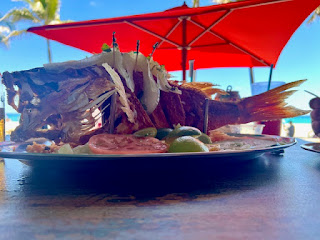People who survived the Soviet satellites of the former Iron Curtain, socialist countries run by their respective Communist Parties, can attest to the lack of food and especially meat they were subjected to daily.
One person who recently talked
about his experience with food in Poland brought back painful memories. It was
common for hungry kids to bully or beat up weaker kids for their sandwich, he
said; their parents were members of the Communist Party and thus had access to healthy
food. He reminisced about his mom buying a sliver of meat to flavor the soup or
stew she was making. Drago was so shocked when he was first offered a piece of
steak in the U.S. He thought it was the food ration for the month.
My mom bought bones with
which she flavored our soups and potato stews. She could not have bought even a
sliver of good meat if she wanted to because it was not available or it would
have been too expensive for our meager budget to buy it on the black market. At
best, she could have bartered something, but she had nothing of value to exchange
for meat.
Such was food rationing
on coupons under tyrannical regimes – empty stores and long lines for bread and
other necessities that were always in short supply.
I visited Dachau’s Nazi concentration
camp 31 years ago and I saw a list in German with the food rations for the camp’s
prisoners. They received every morning 350 g of bread and half a liter of
ersatz coffee, 3 liters of soup for lunch each week, one noodle soup and other
two liters white cabbage soup, and for evening meals four times a week 20-30 g
of sausage or cheese and ¾ liter of tea. No wonder the prisoners who survived
were skeletal. Meat was almost non-existent in their nutrition; they were starved
on purpose.
I watched my mom kill a chicken
sometimes and grandpa slaughter at Christmas the pig he raised; it kept many in
the family alive throughout the year. In retrospect, it did not look like a humane
killing and the pig knew what was happening to him but we needed meat in order
to survive and stay somewhat healthy and functioning.
I also remember grandpa burying a pig one year in the back yard because the
village vet tech told him that it had trichinosis, and it was not fit for human
consumption. But some villagers did eat their sick pigs and died or survived
through treatment. A few of my childhood friends died of parasitic infections -
they were not lucky to be close to a free medical clinic for treatment.
Some village kids drowned in the creek or in the Proava River when it rained a lot,
and the muddy brown water concealed their bodies until the level dropped.
Nobody knew how to swim. I never learned until I was almost 21 and living in
the U.S.
My aunt Nuta used to take me and my best friend Steluta to the Prahova River -
the water was clear and so cold, coming down from the mountains. There were
pockets between large boulders where the water was deeper, and the fish were
trapped in. We bathed with fishes swimming around us. We were hungry all the time,
but it never occurred to us to try to catch the fish. We were afraid that
someone would report us to the communist government, and we would go to jail.
Finding abundant meat to
eat in the U.S. reminds us of the reality that every day we live, a creature
dies to keep us alive. We just do not realize how much killing we do because
someone else does the killing for us.
I am obsessed with the
show ALONE for several reasons. One is the killing of animals in a survival
setting where they are truly alone and must find meat protein, clean water, build
a good shelter, and provide heat. Part of finding food is not just picking
berries or edible plants which can be boiled and turned into soup. They must
hunt and catch wild animals; unless trained, we lost that skill a long time
ago. Most of us today would not know how to humanely trap and kill an animal to
eat. We do eat meat but are squeamish about the actual killing.
A lady survivalist
snared a squirrel, and the momma squirrel came and was trying to revive her
baby and she was making all these crying sounds. It was heartbreaking to hear -
animals are sentient beings.
A survivalist from West Virginia who hunted and killed with his bow and arrow a
beaver in Labrador, Canada, contracted giardiasis, a parasitical infection from
the beaver meat - he called it ‘beaver fever.’ Worse still, he had to undress
down to his underwear and swim in the freezing river water to retrieve the dead
beaver which was floating in the middle.
He got so sick after eating undercooked meat and fat from this beaver that he
had to tap out to seek medical help. This was the revenge of the beaver for
killing him and leaving his mate alone for life.
But we know that in the circle of life animals eat other animals and maul
humans as well if they are in their habitat or vicinity, and they happen to be
hungry. Some even slaughter humans for the sport even when not hungry.
Meat has been part of the
human diet for 2.6 million years despite the modern time push for
vegetarianism. We are lucky in the U.S. that we have such a supply of meat, enough
to trade with other nations.

